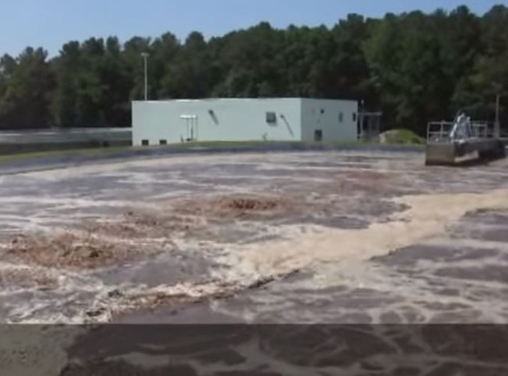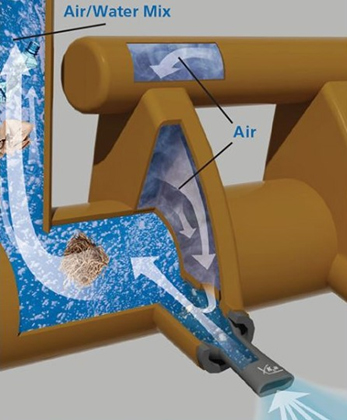The presence of dissolved solids presents both physical and financial challenges for aeration diffusers in any wastewater treatment operation and can be particularly problematic in high-concentration industrial and food-processing applications. Here are some warning signs, insights, and solutions for coping with conditions that can lead to excessive dissolved solids accumulation.

Getting To The Source Of The Problem
Depending on the source water supply for the region, the wastewater flow to be treated might already be high in mineral content. Regardless of what that starting point might be, however, when the pH of wastewater is acidic, quicklime — calcium oxide (CaO) — is typically added to achieve the neutral pH needed to support wastewater microorganism growth. Unfortunately, those additions can also have a ripple effect in raising the calcium carbonate (CaCO3) levels of the wastewater.
The genesis of dissolved solids can also be a natural part of the production process. For example, calcium is an important part of pulp and paper processing methods. In some film-making processes where gelatin is extracted from calcium-rich animal bones, residual calcium in the wastewater can also exacerbate problems. That is because the calcium reacts with carbon dioxide (CO2) generated as a byproduct of wastewater microorganism biological processes to form CaCO3 as the CO2 is coming out of solution.
Whatever the source of the dissolved solids, they can become a nagging problem for wastewater treatment efficiency when they begin to clog and compromise the performance of aeration headers, orifices, nozzles, or jets over time. In extreme cases, dissolved solids buildup can clog micron-sized air-diffuser openings in as little as six months.

Figure 1. Notice the large ‘boils’ at the center and left of this photo resulting from clogged aeration headers that produce fewer and larger bubbles that rush right to the surface and minimize oxygen transfer efficiency.
Warning Signs Of Dissolved Solids Precipitation
For industrial wastewater operators, there are multiple indicators where the presence of CaCO3 or other dissolved solids start to pose an elevated risk of aeration problems:
- Aeration Patterns. A buildup of dissolved solids at air-discharge openings will change the flow of air, the size and number of the bubbles, and the aeration pattern on the surface of the aeration basin. Fewer, larger bubbles escaping straight up from clogged orifices will show a few concentrated areas of large “boils” instead of a dispersed pattern of fine aeration (Figure 1).
- Pressure Readings. The ramping up of aeration blower pressure readings in an aeration system can tip off both the early stages and the relative progression of blockages caused by dissolved solids.
- Overheated Blowers. As the obstruction of aeration openings and relative backpressure on the aeration blowers increase, it is possible to experience those units heating up to the point where they trigger high-temperature safety-switch shutdowns.
- Instrument Readings. Total dissolved solids (TDS) and total suspended solids (TSS) measurements can help wastewater professionals track the extent of potential dissolved solids problems. Also, significant drops in dissolved oxygen (DO) levels will indicate when those problems have affected the aeration system to the point of compromising the wastewater treatment process.
Discouraging And Mitigating Dissolved Solids Buildup
While preventive efforts are the best step for delaying or minimizing scale formation, once scaling becomes obvious, there are multiple approaches to mitigating its effects:
- Big-Picture Strategies. Situation monitoring and periodic maintenance can help operators ensure that an aeration system functions at an acceptable performance level for a longer period of time. In particularly aggressive dissolved solids environments, however, serious consideration should be given to replacing air diffuser systems with more versatile jet aeration or slot-injection aeration systems.
- Aeration System Options. In particularly aggressive dissolved solids environments, conventional air diffuser systems can suffer the impacts of clogging within six months of installation. In those cases, aeration alternatives such as jet aeration or slot-injection systems that use wider openings can provide built-in clog-resistant features for longer periods of unobstructed operation — often five years or longer.
- Situation Monitoring. Whatever the concentration of dissolved solids or the type of aeration system, keeping track of performance is important to show when aeration efficiency threatens to fall below acceptable levels. This can include monitoring water chemistry for TSS, TDS, and DO, as well as monitoring aeration blower performance for pressure and energy consumption and charting the resulting trends.
- Periodic Maintenance. Considering the propensity for a specific wastewater treatment application to show the effects of dissolved solids precipitation — even with wider jet nozzle openings — it can be wise to schedule periodic maintenance activities. In extreme cases, that could mean adding a spare treatment basin and rotating basin use to allow one to be taken down and cleaned periodically. Doing so can prevent compromising the performance of the system to the point of a discharge failure and forcing an unplanned shutdown. It can also help to maximize the value of the capital investment over the long term.

Figure 2. Periodic backflushing of slot-injection and jet-aeration nozzles can help to dislodge debris and scale formation to keep oxygen transfer efficiency high for longer periods, even in extremely challenging industrial and food-processing wastewater applications.
- Short-Term Tactics. Using appropriately designed jet or slot-injection aeration systems for high-TDS environments can create added options for short-term preventive actions against dissolved solids buildup:
- Backflushing. Regularly backflushing a jet aeration or slot-injection aeration system can help to extend the time period between forced shutdowns for more in-depth maintenance procedures (Figure 2).
- Acid Treatments. In particularly high-TDS environments, buildup is most prone to occur in the low-pressure zone of a jet aerator — the air feed side. Adding an acid solution into the air feed line in the form of a mist can help to forestall problems at the air entrance to the jet.
- Combined Preventive Efforts. One beverage production plant that had an excessive problem with lime — used to neutralize the pH of its highly acidic juice — combined both backflushing and acid treatments to be successful in extending the functional time for keeping aeration pathways open.

